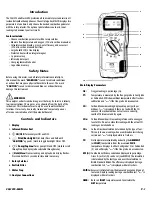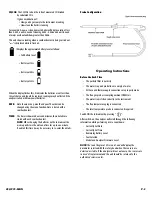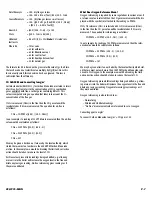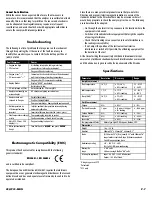
C50/C75-MAN
P. 7
Charging
Ensure that you use the correct charger. This unit uses a 9V DC
regulated charger.
Ensure that the batteries are fitted in the correct manner, and then
charge for at least 16 hours. Subsequent charges should be overnight.
NiMH batteries may be charged at any time, even for short periods to
conduct testing.
WARNING!
Under
NO
c i rcumstance should you expose batteries to ex t reme heat or
f i re as they may explode and cause injury. Always dispose of old batteries
p romptly in a manner consistent with local disposal re gu l a t i o n s .
Emptying and Cleaning the In-line Water Trap
The in-line water trap should be checked and emptied on a regular
basis. Water vapor will condense in the probe line, which may cause the
water trap to fill suddenly if the probe is moved. Care should be taken
at all times.
Carefully remove the rubber plug from the bottom of the water-trap
housing. Dispose of the condensate in a suitable drain, care must be
taken as it could be acidic.
If condensate spills onto the skin or clothing, clean off immediately
using fresh water, seek medical advice if problems occur. Ensure plug is
replaced before performing combustion tests.
Changing the Particle Filter
This is a very important part of the analyzer and should be changed
regularly. It prevents dust and dirt particles from entering the pump
and sensors that will cause damage. The filter MUST be changed when
it appears discolored.
Remove water-trap assembly from the analyzer as shown above.
Remove the filter and plastic holder from the housing. Discard the filter
element but keep the holder to fit to the new filter. Clean the inside of
the filter housing with a suitable soft cloth. Fit the holder onto the new
filter element and then insert into the housing. Refit the housing onto
the analyzer.
Hook slides
out of dock
Slide outward
Pull plug out
to drain
Insert a new filter
M a i n t e n a n c e
Periodic Service
WARNING!
Repair and service of this instrument is to be performed by qualified
personnel only. Improper repair or service could result in physical
degradation of the instrument. This could alter the protection from
personal injury this meter provides to the operator. Perform only those
maintenance tasks that you are qualified to do.
These guidelines will help you attain long and reliable service from
your meter:
• Calibrate your instrument annually to ensure it meets original
performance specifications
• Keep your instrument dry. If it gets wet, wipe dry immediately.
Liquids can degrade electronic circuits
• Whenever practical, keep the instrument away from dust and
dirt that can cause premature wear
• Although your instrument is built to withstand the rigors of daily
use, it can be damaged by severe impacts. Use reasonable
caution when using and storing the meter
Cleaning
Periodically clean your instruments case using a damp cloth.
DO NOT
use abrasive, flammable liquids, cleaning solvents, or strong detergents
as they may damage the finish, impair safety, or affect the reliability of
the structural components.
Battery Replacement
This meter has been designed for use with both alkaline and
rechargeable Nickel Metal Hydride (NiMH) batteries. No other types
are recommended. The analyzer is supplied with 4 “AA” size alkaline
batteries. These should be installed into the instrument as shown below
(Fig 1) and indicated on the back of the unit.
CAUTION!
Take great care when installing the batteries to observe correct polarity.
Always check the meter for operation immediately after installing
new batteries.
Using Re-Chargeable Batteries
The battery charger must only be used when NiMH batteries are fitted.
Alkaline batteries are not re-Chargeable. Attempting to recharge alkaline
batteries may result in damage to the product and may create a fire risk.
(Fig 1)
Note: Battery Direction
Battery Compartment
Cover
Back of
Instrument





























